Back in November 2015 I took some time to travel back to China to visit somewhere weird: TianDuCheng (天都成), China’s Replica Paris.
It was my first time in the country since moving from Shanghai to Austin, Texas. After reconnecting with old friends and visiting some favorite bars, I took the opportunity to visit somewhere I’d never been.
After mustering enough Mandarin to hail a taxi to the extra-large Shanghai Honqiao Railway Station, I took the bullet train southwest to Zhejiang Province’s largest city, Hangzhou. Home to Alibaba and the famous West Lake, I wasn’t looking for a city I’d visited numerous times. I was in Hangzhou to take a 125 yuan Uber Black ride some 45 minutes to the village TianDuCheng (天都成): China’s Replica Paris.
Built by the the publicly-traded China Guangsha Real Estate Company in 2007, the 1/3 scale Eiffel Tower had popped on weekend trip itineraries in expat magazines and websites during my three years living in Shanghai. After moving back to the US I also read Bianca Bosker‘s excellent “Original Copies: Architectural Mimicry in Contemporary China,” which featured Tianducheng on its cover. Since I didn’t know the next time I was going to be in China, I had to take advantage of this curious locale.
Getting (Dis)Oriented
Tianducheng isn’t the only replica village surrounding China’s largest city. There’s Thames Town, a replica of an English village; Pujiang New Town, a modernist interpretation of Venice; Anting New Town, a German Bauhaus-inspired village and the aptly-named Fengcheng Spanish Town.
So, after arriving at a grand fountain near the entrance of the French-themed Tiandu Amusement Park, which contains replicas of fountains and architecture of various parts of France, I knew I was in the right place. The scene already felt like an amalgamation of many French places rolled into one.

After taking a few photos of the fountain, I turned around and immediately saw a picturesque scene which briefly took me away from China to a glimpse of my visit to Paris in 2006 at 19 years old:
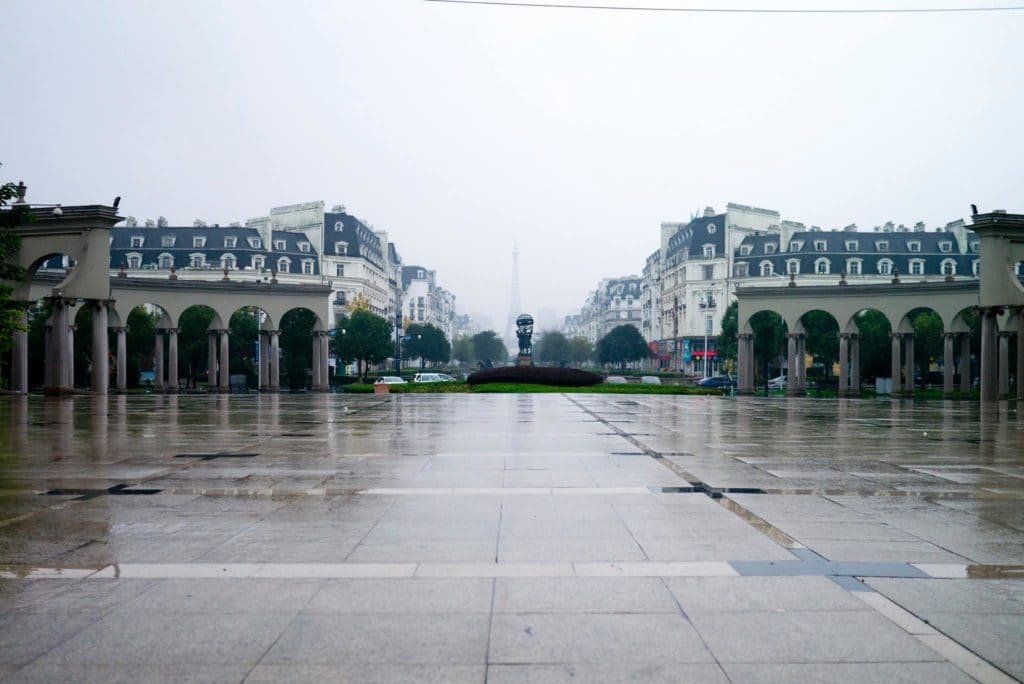
From afar the view was very familiar. The buildings and focal point had the right shape with very Parisian buildings to boot. But after thinking more about the view as I was taking photos, the more it seemed incorrect. I don’t remember rows of Haussmann style apartment blocks lining the thoroughfare from Jardins du Trocadéro to the Eiffel Tower. As I continued to walk closer, the Impressionist-like interpretation of a Paris in China came into focus.
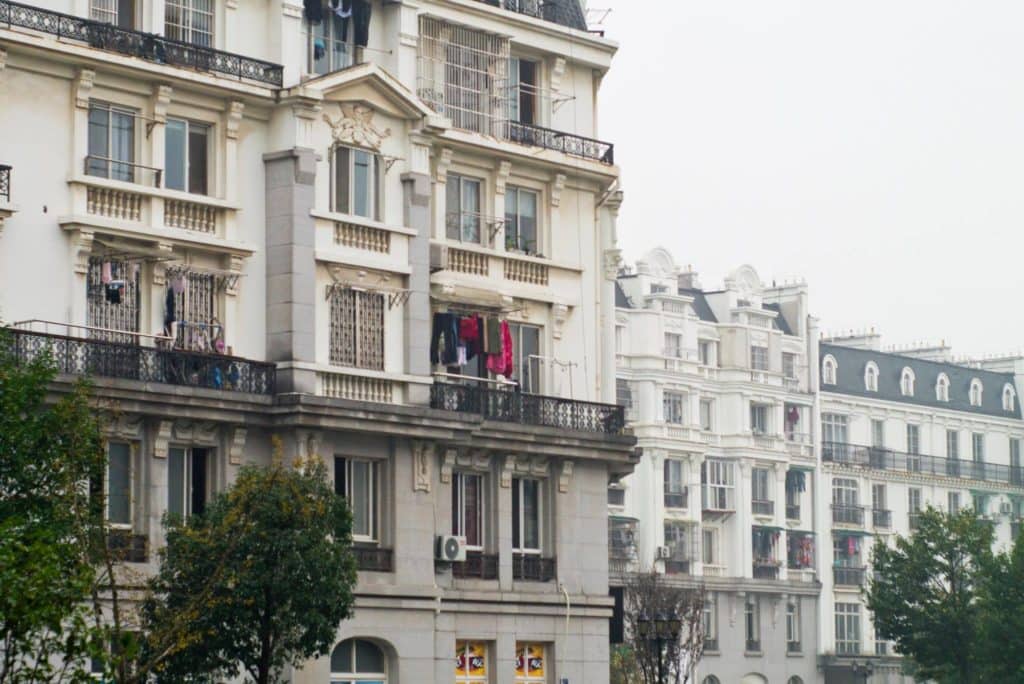
The apartment buildings had cages and laundry hanging around the windows. Something I definitely didn’t see in Paris, but something I often saw in China. Despite the buildings being less than a decade old, they appeared to be in a state of disrepair giving it it’s often-touted “Ghost City” status.
Many of the (occupied) shops those found on most urban Chinese streets. Cooking oil and baby powder shops, real estate brokers and restaurants made it feel like a Chinatown in any global city. Otherwise, the town was empty. No shoppers, few pedestrians and many empty storefronts. But after I stepped in a Lanzhou noodle shop of the sort I often frequented in Shanghai, I was quickly transported back to my China as I knew it.
‘Replication of The Alien’
When I ate my lamb noodles I wondered, “Why does this place need to exist?” and, “Do the people here even care it’s an approximation to Paris?”
Thankfully, Bosker’s book addresses many of these questions. Without giving a woefully short abstract of the book, “Original Copies” focuses on a few key points of why China likes to builds developments like this.
With China’s explosive growth and evolution from Communist-Agrarian to “The World’s Factory,” there is an often-cited reason for the country’s architectural mimicry. One belief, as noted by Bosker in her book, is that China can symbolically be as powerful as advanced Western nations by replicated their famed buildings. This explains why so many buildings around China are replicas of American seats of power, like the Capitol and the White House. As described by Bosker:
[T]he impulse to re-create the past and duplicate the alien is deeply Chinese. China’s traditional perspectives on the replication of the alien have, even in the present day, fostered a permissive climate for such copycat constructions.
And described later in the book:
Certainly, “originality” — synthesizing tradition and innovation to transform models and “produce something unprecedented” — has great value in China too. Yet concurrently, the ability to render a good copy has, historically, been taken by the Chinese as a marker of technological and cultural superiority, and the coexistence of an original and its virtually indistinguishable double does not trigger the ontological crisis that is characteristic of the West.
Additionally, Bosker theorizes that China’s fascination with European architecture and design as a symbol of luxury and class relates to a lack of Chinese signals for luxury in a Communist system designed to be devoid of class. According to Bosker, this explains why there’s no replication of unique senses of place like New Orleans, Chicago or Texas. Only those places that have a “distinct connection to fine living have succeeded in capturing the Chinese imagination.”
Getting Close Up
After I finished my noodles I finally walked over to the base of the Eiffel Tower replica. When I walked to the end of the apartment blocks, the familiar Parisian vista became overshadowed by new, modern looking apartment blocks that may actually be taller than the 1:3 scale Eiffel Tower.
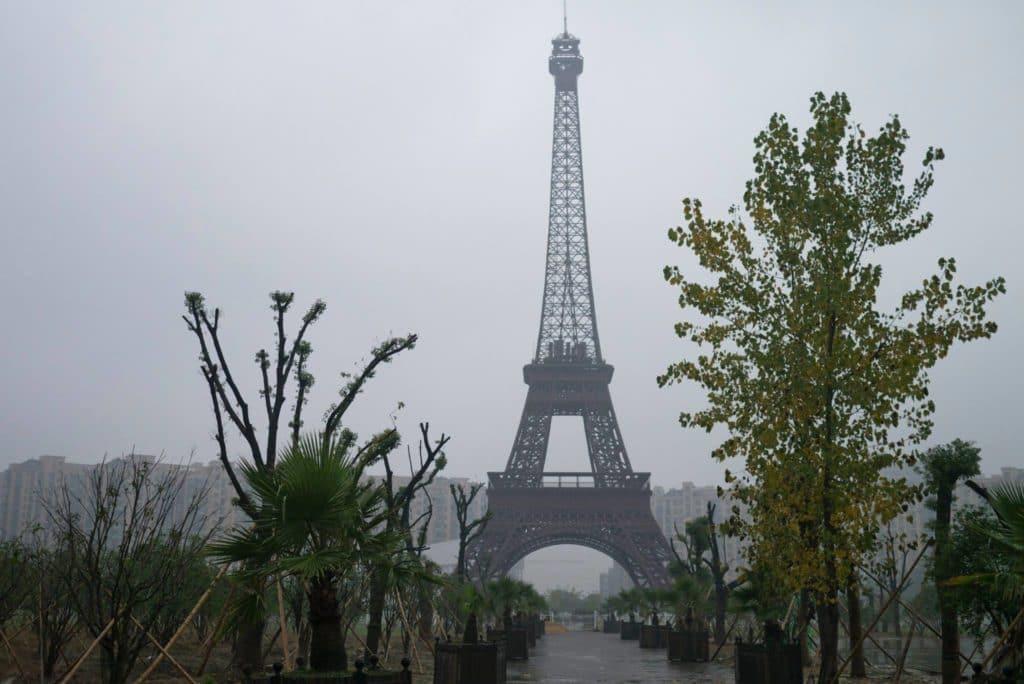
That’s when things got really weird. From there, you can see a small ramshackle shack for a live-in groundskeeper and a small plot of farmland used by locals. But otherwise, access is generally restricted. You can easily hop the fence to wander around, but there’s nothing really to see.The ongoing rain and fog (actual fog, not smog) made it look extra apocalyptic. After taking a few bizarre selfies I made my way out of the park to circumvent the ghost town.
After I snapped a few photos and wandered around a bit more, I noticed that as the rain picked up the area surrounding the tower puddles started forming. Despite ongoing construction around the tower and the relatively new buildings, there were no drains. As I waited for a taxi to take me back to Hangzhou I realized much of the new construction was as much a facade as the Huasmann apartments and Eiffel Tower itself. It all looked good on the outside but somewhat incomplete under the surface.
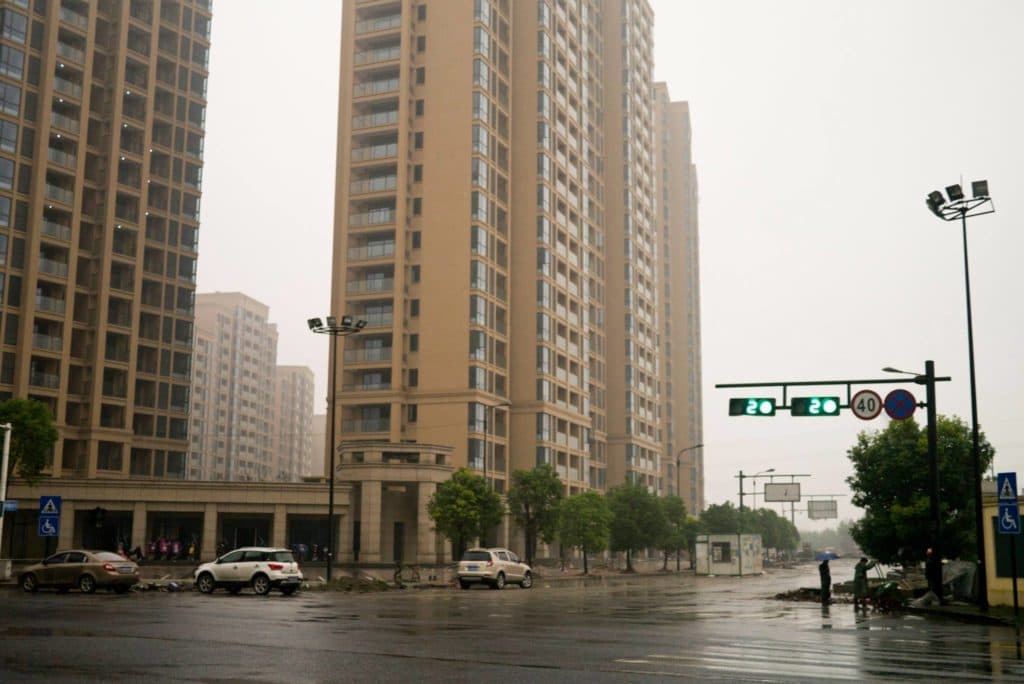
On my ride back, I tried to do more reading about Tianducheng online. According to Baidu’s Baike, a Wikipedia-like resource on the Chinese Web, the development has about 2,500 households with about 4,000 residents. Real estate prices are between 10,500 to 12,000 yuan per square meters, which is commiserate to prices in Hangzhou city center.
On Baike it doesn’t appear that the Eiffel Tower replica was was planned as part of the construction. However, China Guangsha does feature the skyline of Tianducheng on their English website. So, while outsiders often deride China’s blatant shanzhai architecture, this bizarre places still feels like a point for others.
Click here to read my analysis of Jamie xx’s music video for “Gosh,” also shot in Tianducheng.
Getting There
From Shanghai, go to Shanghai Hongqiao Railway Station (Lines 2, 10) and buy a ticket for the Shanghai-Hangzhou Passenger Railway Service (沪杭客运专线). The ride is about an hour and runs frequently.
Once in Hangzhou, you can take a bus or subway from the train station to Liping Station (Red Line/1), but it may take you several hours. Take an Uber or Didi ride to be there much faster.

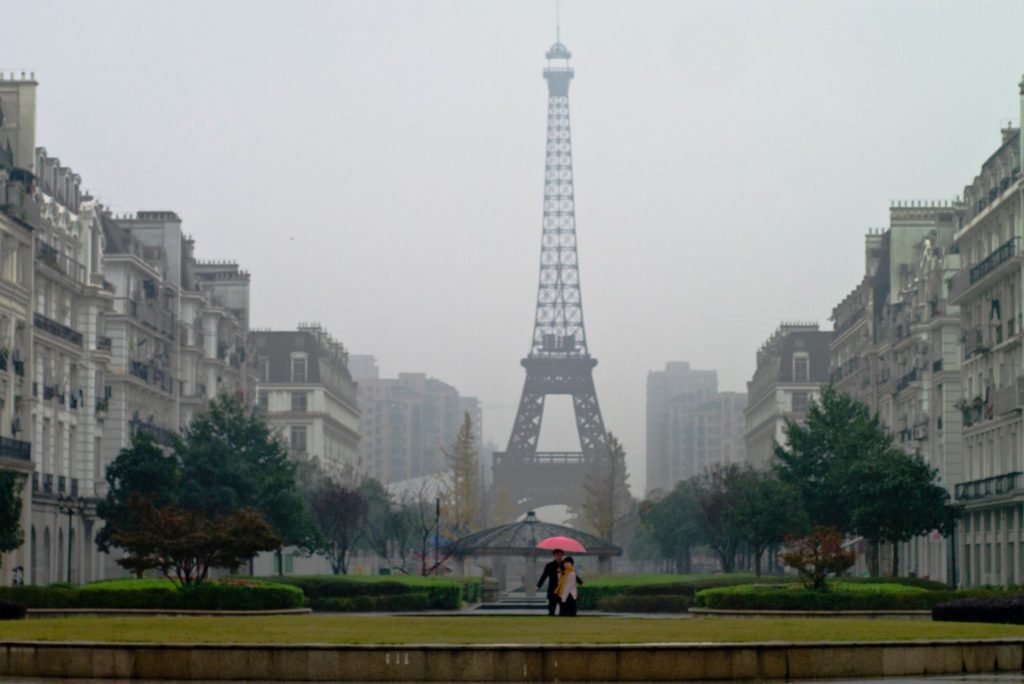
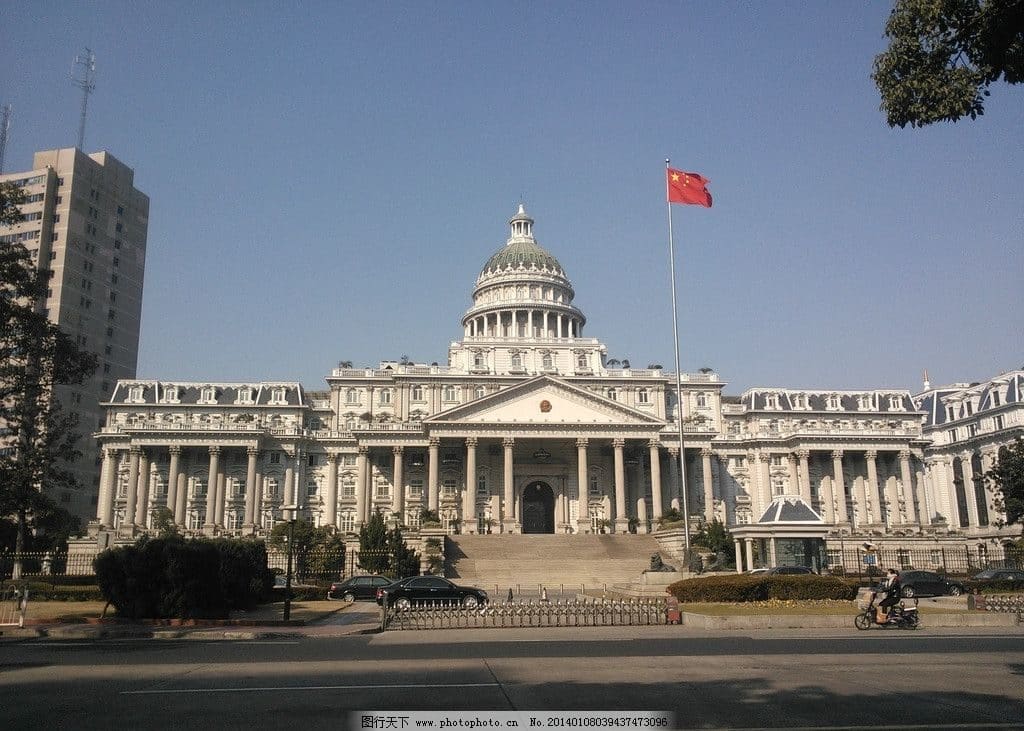

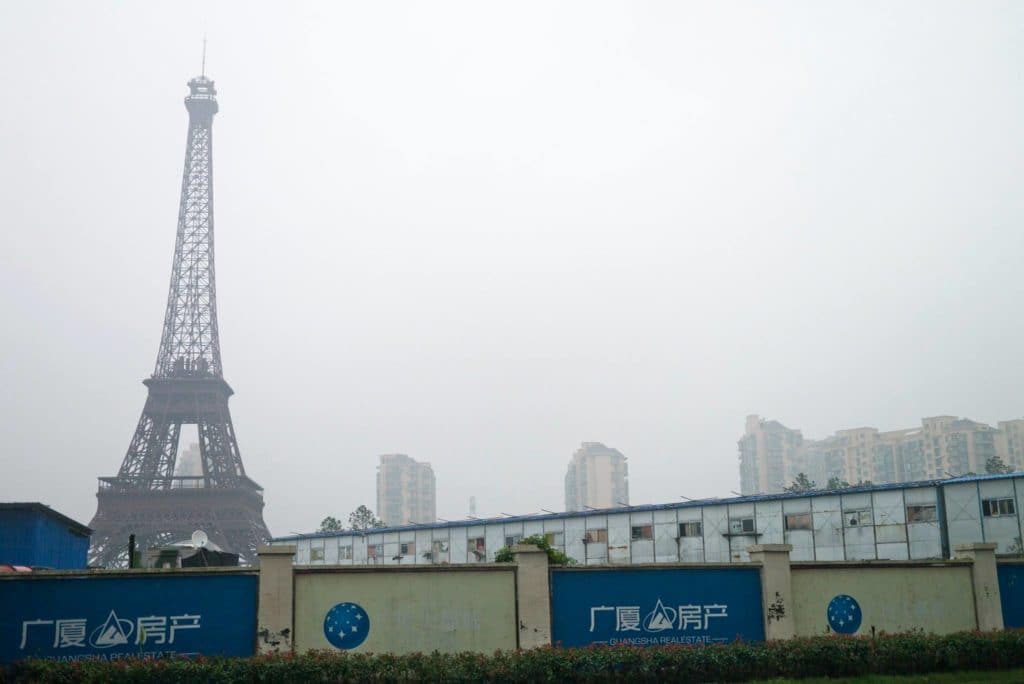
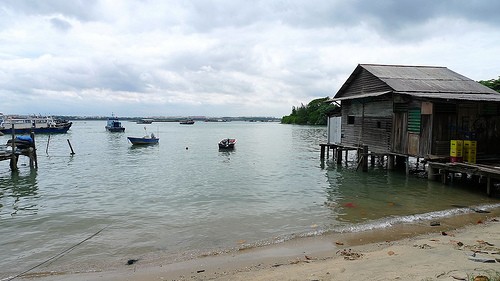
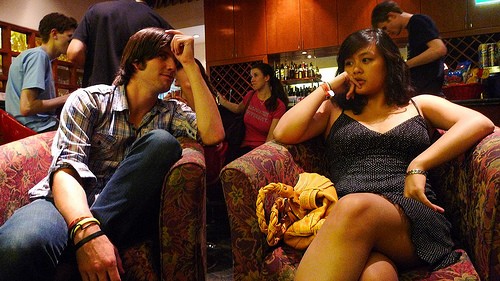
One thought on “Visiting China’s Replica Paris”